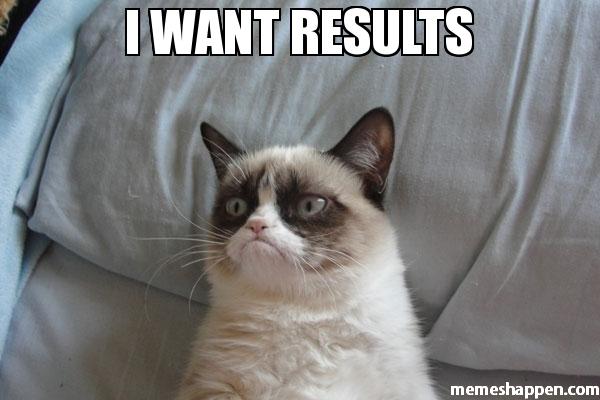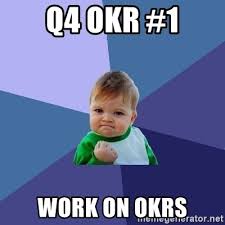MBO, OKR, PPR: mix but not shake
Let's talk about goal setting techniques. This topic is relevant in almost all companies. How to set goals? How to achieve goals? How can I not get a formal formal reply in the style of “I will work long and hard”, but without any specifics? Such goals are good as an “emotional charge”, but are completely useless in terms of achieving a result. Immeasurable, non-obvious, and therefore unattainable.

There are a lot of goal setting methods, we conducted several experiments at Raiffeisenbank, and I want to talk about the pros and cons of these approaches. Somehow it turned out that all the methods easily turn into three-letter abbreviations, we will try not to get confused in them.

The classic technique , invented by Peter Drucker in the mid-twentieth century. In the canonical version is a list of SMART goals for the year, which the employee and the manager discuss as a kind of social contract. According to the classics, in the middle of the year it is customary to revise / refine these goals and at the end of the year evaluate the results .
Example MBO goal:
The advantages of this approach:
Cons of this approach:
And how does it work in our bank?
For us, an MBO is a big vector for a year without defining specific tasks. These are key financial indicators that the entire bank wants to achieve, these are indicators of customer satisfaction and employee engagement. And all year we try to find the best approach to achieving these indicators. And they help us with this OKR.

Recently, only the lazy does not write about OKR. Probably, the truth has already been lost in history, but it is claimed that for the first time the OKR method was invented by Intel, and it gained its popularity thanks to Google, Oracle, Linkedin and Twitter.
As Russian Wikipedia tells us , as well as other sources , the essence of the approach is that the company / department / specific employee defines several difficult goals for himself for a certain period of time (usually a quarter); For each goal, 3-5 measurable criteria are assigned, by which progress in achieving the goal will be tracked.
The method assumes that the goals are set as ambitious as possible, in this regard, the achievement of 70% of the goals indicates success. Situations in which the goal is 100% achieved are more likely to indicate unambitiousness.
Example OKR
Suppose you are the owner of a chain of stores, and set yourself the goal: "increase the number of stores in the network by 20%."
A side note for those who are interested: I recommend a site where you can practice writing OKR and see many examples from different industries.
The advantages of this approach:
Cons of this approach:
Learning to think in goals instead of tasks takes a long time, and not everyone likes this story.
How does OKR work in our bank?
The practice itself is not accepted at the level of the entire organization, but there are separate teams that work quite successfully with OKR, and this is another plus of the system: you can start with yourself without trying to change everything around at once.

I will describe the work of the methodology as an example.
The format of the meeting:
Many companies in the world use a similar technique, supplementing the standard format for employee assessment conducted by the leader. PPR is often confused with 360 surveys, but this comparison is not entirely true, because PPR is carried out in person and only with colleagues - that is, employees from your own team, without customers and subordinates.
The advantages of this approach:
Cons of this approach:
How does PPR work in our bank?
By analogy with OKR, the technique works in separate teams, I observed interesting situations when the same teams, changing the composition, left and returned to PPR practice.
The answer will be standard: that suits your company specifically and meets the conditions in which it exists. It seems to me that a bunch of MBO (big goals for the year) + OKR (short goals for the quarter) + PPR gives good support to the team and allows you to achieve results.
How do goal setting and evaluation processes work in your teams / companies? Share life hacks!

There are a lot of goal setting methods, we conducted several experiments at Raiffeisenbank, and I want to talk about the pros and cons of these approaches. Somehow it turned out that all the methods easily turn into three-letter abbreviations, we will try not to get confused in them.
Goal Management ( MBO )

The classic technique , invented by Peter Drucker in the mid-twentieth century. In the canonical version is a list of SMART goals for the year, which the employee and the manager discuss as a kind of social contract. According to the classics, in the middle of the year it is customary to revise / refine these goals and at the end of the year evaluate the results .
Example MBO goal:
- Attract 1.5 million customers to the premium segment and ensure that the ratio of expenses to revenues in the segment is not more than 34%.
The advantages of this approach:
- The system is scalable, it works both in small companies and in very large corporations.
- It is possible to cascade goals from CEO to lower levels of the hierarchy.
- In a standardized system, units are easier to share cross-goals.
Cons of this approach:
- Setting goals for the year (even with a semi-annual review) is monstrously not flexible in 2018. The market is changing at a crazy speed and some goals may lose relevance within a month. The system should allow you to respond very quickly to this.
- MBO, as an approach, does not limit the number of goals, and often we end this exercise with a list of 10 goals and an average weight of 10% each. There is a confirmed hypothesis that an employee cannot focus on 10 goals at the same time, and in general, the presence of 10 “most important things” is very doubtful.
- Unfortunately, there are very few companies on the market that follow the initial idea of writing SMART goals, and therefore we often get goals in the format “Ensure high quality business processes”, an immeasurable amorphous nonsense that perfectly closes someone’s inefficiency.
And how does it work in our bank?
For us, an MBO is a big vector for a year without defining specific tasks. These are key financial indicators that the entire bank wants to achieve, these are indicators of customer satisfaction and employee engagement. And all year we try to find the best approach to achieving these indicators. And they help us with this OKR.
Objectives and Key Results ( OKR )

Recently, only the lazy does not write about OKR. Probably, the truth has already been lost in history, but it is claimed that for the first time the OKR method was invented by Intel, and it gained its popularity thanks to Google, Oracle, Linkedin and Twitter.
As Russian Wikipedia tells us , as well as other sources , the essence of the approach is that the company / department / specific employee defines several difficult goals for himself for a certain period of time (usually a quarter); For each goal, 3-5 measurable criteria are assigned, by which progress in achieving the goal will be tracked.
The method assumes that the goals are set as ambitious as possible, in this regard, the achievement of 70% of the goals indicates success. Situations in which the goal is 100% achieved are more likely to indicate unambitiousness.
Example OKR
Suppose you are the owner of a chain of stores, and set yourself the goal: "increase the number of stores in the network by 20%."
- KR1: Select 40 franchise opening candidates by the end of May.
- KR2: Train 30 of them by the end of June.
- KR3: Sign contracts from 25th to the end of September.
- KR4: Open 20 stores until December.
A side note for those who are interested: I recommend a site where you can practice writing OKR and see many examples from different industries.
The advantages of this approach:
- Well-articulated OKRs are becoming a fantastically useful goal-focused tool. You do not have a “blurry blob”, spread out for the whole year. There is an extremely specific goal for the short term.
- There aren’t many OKRs, so you’ll definitely consider what is important to you at the moment before setting goals. A number of studies say that more than 50% of top managers find it difficult to name their five main priorities. And OKR is one of the tools to solve this problem.
Cons of this approach:
- Learning to single out the most important thing is really hard at the level of the company - the team - employee. And therefore, often there are incidents like "my OKR list is what I do daily", that is, they write stuff in OKR.
- Instead of goals, tasks are often written in OKR, for example:
“Reduce the waiting time in the queue at the client in the department to one minute” instead of “increase the client NPS (net promoter score, consumer loyalty index) when contacting the department up to 35%”.
Learning to think in goals instead of tasks takes a long time, and not everyone likes this story.
How does OKR work in our bank?
The practice itself is not accepted at the level of the entire organization, but there are separate teams that work quite successfully with OKR, and this is another plus of the system: you can start with yourself without trying to change everything around at once.
Group Performance Assessment ( PPR )

I will describe the work of the methodology as an example.
The format of the meeting:
- At the meeting, choose a coordinator.
- The assessed employee shares his vision of the previous period with OKR.
- The coordinator in turn invites participants to ask clarifying questions , without ratings. Evaluated tries to answer briefly but succinctly.
- The coordinator in turn invites the participants to express an opinion in a free form (what you like, what was not enough, what you need to pay attention to).
- The coordinator offers the evaluator to comment on the opinions heard.
Many companies in the world use a similar technique, supplementing the standard format for employee assessment conducted by the leader. PPR is often confused with 360 surveys, but this comparison is not entirely true, because PPR is carried out in person and only with colleagues - that is, employees from your own team, without customers and subordinates.
The advantages of this approach:
- You, as an employee, hear all the opinions of the team about your results . This is very important in order to see the widest possible perspective. If you value feedback and consider it a “fuel” for development - this tool is for you
- Regular PPRs help build trust in the team. We are no longer trying to find out how the colleague was evaluated by the leader, we ourselves take part in the assessment. It is often much more difficult to hide something from the members of your own team than from a leader with a blinded look, so such situations will also quickly come out.
Cons of this approach:
- Initially, people are completely unprepared to openly comment on anything in relation to other employees. This is especially evident in teams with a low level of trust. You get PPR in the format “no questions, no comments”, and the whole idea turns into profanity.
- Such formats need to be able to coordinate, smooth out the emotional tension and not let the meeting turn into a quarrel. Often in the heat of the moment, old grievances begin to be recalled and the conversation leaves the discussion of the results in a discussion of personalities.
- They say that there is such a thing as “Russian & Polish Feedback”, the essence of which is that we only praise for Olympic gold and scold even for spilled tea. And often you need to rock the team so that it not only “gives constructive feedback”, but also praises your colleague, paying tribute to his merits.
How does PPR work in our bank?
By analogy with OKR, the technique works in separate teams, I observed interesting situations when the same teams, changing the composition, left and returned to PPR practice.
What to choose for you?
The answer will be standard: that suits your company specifically and meets the conditions in which it exists. It seems to me that a bunch of MBO (big goals for the year) + OKR (short goals for the quarter) + PPR gives good support to the team and allows you to achieve results.
How do goal setting and evaluation processes work in your teams / companies? Share life hacks!
